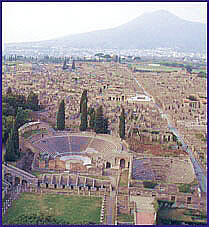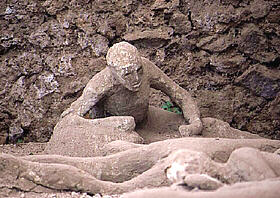POMPEII and HERCULANEUM
Pompeii was a resort town inhabited by wealthy Romans who were known for lavish spending on their homes. The fertile, volcanic slopes of Vesevius provided an ideal climate for grapes and olive groves.
Since the mountain had last erupted long before anyone alive at the time had been born, people thought that living near the most recognizable landmark looming over the bay of Naples was completely safe. The town had imposing temples, a beautiful forum, a perfectly built theater and a stadium.
It was lunch time in August 79 AD when Vesuvius began 19 hours of spectacular eruptions. All the people in the 700-year-old town of 20,000 could have escaped. There was time to flee. But no one recognized the inherent danger of the mountain's warnings.
(Right): Map of the bay of Naples. Pompeii and Herculaneum are 2 hours' drive from Rome
|
|
By the time Vesuvius stopped belching poisonous gas, the bustling city of Pompeii was silent, completely buried by volcanic ash and debris. It remained silent for 1700 years. Herculanum underwent the same destiny, although it was immediately destroyed by hot toxic gasses, and only later covered with layers of lava.

|
The eruption was the first ever to be described in detail. From 30 km (18 miles) west of the volcano, Pliny the Younger witnessed the eruption and later recorded his observations in two letters. Volcanologists now use the term "plinian" for the first stage of devastating volcanic eruptions, as the one occured in the Pompeii eruption, in which dust, ashes, cinders, and rocks erupt high into the air, and in time settle back to earth. This stage may last for hours or even days. No lava flows occur during the plinian stage.
In areas near the eruption, the amount of these materials can be enormous.
During the first eight hours of the eruption of Vesuvius in 79 AD they fell on Pompeii to depths of 2 to 4 meters (8-10 ft.). The heaps of small rocks that landed on the houses caused many roofs to collapse, although the process was relatively slow, allowing most people to excape.
(Left): Aerial view of Pompeii, with the Vesusius in the background. |
In the next stage of the eruption, a superhot cloud of steam and mud (called "pyroclastic") flowed down the side of Vesuvius. At the speed of 30 mt. per second (nearly 100 Km or 60 miles per hour, as the bird flies), it took less than four minutes for the boiling mud to flow from Vesuvius to both Pompeii and Herculaneum, a sea port distant about 7 kilometers (4 miles).
As mentioned, up to 4 meters (13 ft.) of ash and rocks fell on Pompeii, burying everything except the roofs of some buildings. The city was abandoned and its location forgotten.
In 1595, excavations discovered artifacts at Pompeii and centuries of pillaging followed. Archeological excavations began in the mid-nineteenth century. Now, much of Pompeii has been excavated and it has revealed much about how people lived during that time (and how they died during the eruption).
Herculaneum was buried under 23 mts. (75 ft.) of lava. Once a seaside resort with 5,000 inhabitans, the former town became inland, and is now surrounded, actually surmounted by the modern city of Ercolano.
(Right) Pompeii, Venus Villa |
 |
Surprisingly sophisticated, Pompeii had a grid lay-out (right photo). It had a three-stream running water system. One stream went to public fountains, another to public baths, and a third traveled to homes of wealthy residents. People in Pompeii even had a version of indoor plumbing, but they did not have a good sewer system.
Flowing through lead pipes from a central water tower (called the Castellum Aquae), the water delivery system was ingegnious for its day. When water supplies were low, the town stopped the flow of water streams in order of priority. First the wealthy homes were without water, then the public baths. Public fountains were shut down last.
Silent for thousands of years, Pompeii and Herculaneum are now living museums of life in the Roman Empire during the first century of the Common Era.
The sacrifice and horrendous sufferings of its inhabitants resulted in a generous gesture, as they donated us the means to understand not only the architecture of their houses, buildings and infrastructures, but also their paintings, the furniture, and even the ordinary objects for everyday use. We know their habits, their customs, even their political graffiti, or their love messages.
|
 |
We are thus able to understand their culture, having an insight of the ancient world otherwise impossible.

Mills and baker's oven |
People in ancient times used mill wheels to grind flour, and they stored food in large terra-cotta jars. To maintain the food at constant temperatures, all but the top of a jar was buried in the ground.
Pompeii had outdoor food taverns where its citizens could enjoy a snack and a cool drink. Shops were clearly marked with carved signs: a goat for the dairy, grapes for the winery, bread for the bakery. In the baker’s house one could find a fresco of a man selling bread.
(Right): a tavern |

|
In the taverns food was stored in jars built in the counter, to keep them warm, and to be served. This is why in Italian up till now a snack bar is called tavola calda (hot table).
 |
 |
A paved street, with shops |
The amphitheatre |
Streets were paved with cobblestone, shops and private houses would overlook them. Because there was no sewerage system, organic waste and water would run through the steets. Large steps were placed at steet crossings, enabling pedestrians to avoid contact with the waste, while on the other hand carriages could pass through them.
The town was endowed with a huge amphiteatre and large training facilities. Gladiator's fights were the highlight of the shows. Gladiators were very popular, and their fans would write graffiti on walls to boast their exploits.
Typical upper class residences usually included fresco wall murals, a fountain, private baths, mosaic floors, an atrium with and inner garden (called a peristyle), and a shrine.
(Right) Pompeii: Villa of Venus: painting of Venus
|
 |
In the 1860s, Italian archaeologist Giuseppe Fiorelli discovered that mounds of ash often contained the moulds of those who perished in the catastrophe.

Casts of the victims of the eruption |

The cast of a poor chained dog |
This method of retrieving the shapes of Vesuvius' victims, now known as the "Fiorelli method", was even extended to recreating the forms of furniture, doors and shutters on Pompeiian buildings. The casts show the shapes of the victims in their final moments, trying to filter the noxious fumes of the eruption, and to breathe, as the terror-filled faces reveal. The mold of a dog is shown in the right. The poor animal was chained to a post and struggled for hours before finally succumbing to the ash.

Herculaneum: a wine shop, complete with jars |

Herculaneum: mosaic in villa |
The excavations of Herculaneum stretch over a smaller area, yet they are no less interesting. The once sea town as mentioned was destroyed immediately by a super hot cloud of steam and mud, and only later covered with lava. Generally, the archaeological relics are in better shape than in Pompeii, and many objects of everyday like were found.
Top

Visit Rome | Rome panoramic views | Rome apartments and villas | Inquire | Rome travel guide | Rome map | Service | Resources
Roman Homes homepage |

![]()
